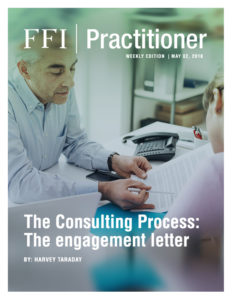
View this edition in our enhanced digital edition format with supporting visual insight and information.
Thanks to this week’s contributor, Harvey Taraday of TCH Partners LLP for his comprehensive examination of an often utilized but seldom examined step of the consulting process, the engagement letter.
Greiner and Metzger, in their book, Consulting to Management, define management consulting as “an advisory service contracted for and provided to organizations by qualified persons to assist in an objective and independent manner to identify, analyze problems, and recommend solutions to these problems.”
To be successful, all communication must be clear and precise. This is especially important when drafting an engagement letter. Many people forget that the engagement letter defines the mandate for the assignment. This is a contract that you prepare which clarifies the relationship between you and your client. It is your interpretation of the client’s objectives, and your consulting plan must be in a format that the client can understand.
This process need not be intimidating or tedious. When managed properly, the preparation of this letter can provide a clear and definable outline and will set out a solid pattern for successful project execution. Not only can this secure a new consulting engagement, but it will serve as a basis for mutual understanding on how the engagement will be conducted.
Where to start
It is best to break the engagement letter preparation process into manageable pieces.
-
- Content: Ensure that you have all necessary client information related to the project. The context describes the overall view of the assignment with respect to the current situation. Key information should include:
1) Client name
2) Client title
3) Legal name of company and mailing address
4) Clearly state the objective. What is the problem?
Project start dates and project end dates will be documented detailing the number of weeks from start to finish
8) Desired end result
B. Additional information: Ask yourself, what else should the letter include? For example:
C. Confidentiality and Deliverables
The engagement letter needs to describe that this assignment will be done on a confidential basis. If the consultant is a member of an organization, refer to its confidentiality rules. This helps to build trust with your client.
It is very important to include a description and list of project deliverables in the engagement letter. Deliverables describe the feedback and reports that the client will be given. It is here that the major outcomes to be expected are outlined. Depending on the engagement, deliverables can be communicated to the client at various stages of the assignment, either verbally or in writing or at the completion of the engagement in writing. Remember to cross-reference the deliverables to the tasks described previously.
An opportunity
The engagement letter is your first opportunity to formally engage the client and ensure that both of you understand and are working toward the same objective. It offers a chance to refine goals and tweak any changes that need to be made. This engagement letter helps you gain client commitment for the project. It is the gateway to adding value to your current practice. Preparation of an engagement letter will help to ensure that the client’s objectives are being met with your work plan and to maintain your firm’s high-quality standards.
About the contributor
 Harvey Taraday, FFI Fellow, is a partner with TCH Partners LLP in Toronto, Canada. He helps family business clients prosper financially and works with them to help grow their human and intellectual capital. He is a member of the FFI Practitioner editorial committee and can be reached at hgt@tchllp.com.
Harvey Taraday, FFI Fellow, is a partner with TCH Partners LLP in Toronto, Canada. He helps family business clients prosper financially and works with them to help grow their human and intellectual capital. He is a member of the FFI Practitioner editorial committee and can be reached at hgt@tchllp.com.
About TCH Partners LLP
TCH Partners LLP, is a firm of chartered accountants who provide state of the art family succession, tax and estate planning for families in business.

View this edition in our enhanced digital edition format with supporting visual insight and information.


